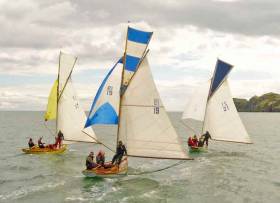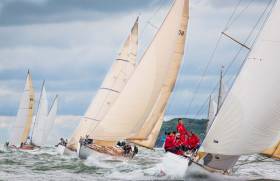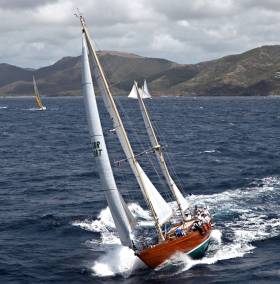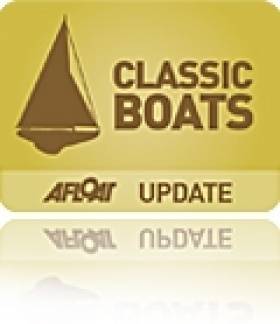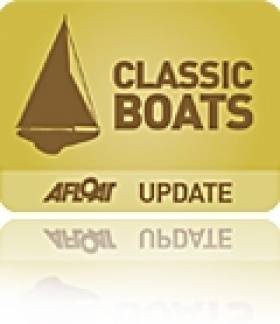Displaying items by tag: CLASSIC BOAT
'Dalkey Boat' Wins Historic Howth 17 Championship
The Massey family’s 1907-built Deilginis of Howth Yacht Club has retained the Howth Seventeen Annual Championship after a five–race series concluded on Saturday with a countback following a points tie with the 1910-built Oona (Peter Courtney) writes W M Nixon.
The combined age of the boats taking part in this well-supported event was 1,487 years. And though this oldest active keelboat class in the world has a strong presence of younger sailors in its makeup of crews, the fact that many boats now find they do best four up meant that the total combined ages involved with people and boats soared through the 2,000 years mark.
But in mostly ideal conditions, Race Officer Neil Murphy was able to get in a complete programme which would have been envied by many younger classes, thanks to putting through a preliminary race on Friday evening, sailed in sunshine and a brisk southwest to west breeze.
 The Friday evening race in a brisk sou’west to west breeze sent the Howth Seventeens away from a traditional pier start through the Sound inside Ireland’s Eye. Photo: W M Nixon
The Friday evening race in a brisk sou’west to west breeze sent the Howth Seventeens away from a traditional pier start through the Sound inside Ireland’s Eye. Photo: W M Nixon
Although Conor Turvey helming the 1988-built Isobel had the best of the start, by the finish Luke Massey had brought Deilginis through to the lead, and at the line it was Deiliginis, Oona and Roddy Cooper’s 1898-built Leila taking the honours.
However, the real excitement was back in the midst of the fleet, where Transatlantic Solo Race winner Conor Fogerty was guest helming aboard the Lynch family’s Echo. In a close encounter on a rolling run with Eileen, the latter’s mainsail came in across the Lynch boat, and their star visiting helm found himself wrapped up in Eileen’s mainsheet, and hauled into the sea.
Any talk of being Lynched was reckoned in the worst possible taste as they got the right people aboard the right boats. And nothing daunted, the Atlantic veteran raced on despite being soaked to the skin, though the 14th place recorded by Echo became her discard.
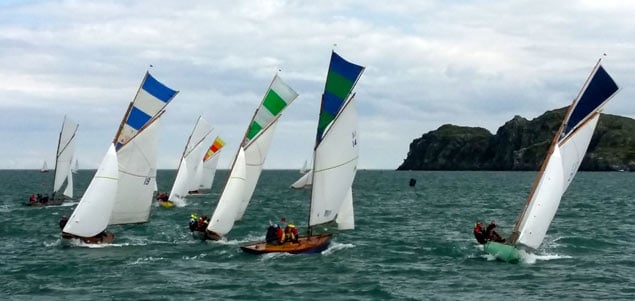 Saturday at first brought plenty of breeze, but topsails were carried throughout. Photo: Neil Murphy
Saturday at first brought plenty of breeze, but topsails were carried throughout. Photo: Neil Murphy
Things were back to normal in the morning, and Saturday’s packed programme was staged in a west to nor’west breeze which was marginal for topsails at first, but with the forecast for wind strengths to ease as the day went on, the fleet went forth with full sail set.
It was intriguing to note the different levels of skills being shown in the arcane arts of setting a jackyard tops’l. The fact that Peter Courtney’s family have been involved with the class since 1907 suggests that it’s an inherited talent, as the topsail on Oona was in place to perfection, setting as one with the mainsail, whereas some other boats had inefficiently large gaps between the jackyard and the gaff.
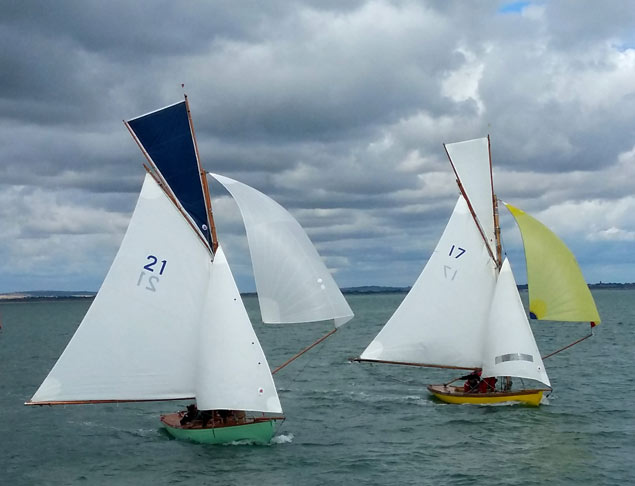 The new French-built Orla (Ian Malcolm, left) and Peter Courtney’s Oona, which had the best-set topsail in the fleet. Photo: Neil Murphy
The new French-built Orla (Ian Malcolm, left) and Peter Courtney’s Oona, which had the best-set topsail in the fleet. Photo: Neil Murphy
Despite the style of her topsail setting, Oona was back in third in Saturday’s first race, but Deilginis was on a roll with another win. However, the Courtney boat then moved rapidly up the ranking with two firsts in Saturday’s second and third races, while Deilginis logged a sixth and a second. This meant they were head to head in the final race with Deiliginis in cover on Oona, while the brand-new French-built Orla (Ian Malcolm) read a windshift to perfection to take the win, with second going to the Turveys and Isobel, and Deilginis and Oona coming in third and fourth.
With them tied on 7.0pts after discards, the quick judgment was that Oona must have it, as she discarded a fourth while Deilginis dropped a sixth, and they both had a scoreline of two firsts, a second and a third. But somewhere in the deepest depths of World Sailing Rules it apparently says that in the event of a tie, the placings in the final race are the decider, with discards ignored, so Deilginis retained the title she won in 2016, with Oona second, Isobel third and the new Orla fourth on a 4th, 5th, 6th and 1st, with an 11th discarded.
In a class of this size, the availability of handicaps adds greatly to the commitment of the fleet, and the placings in this division were 1st Gladys (Pat Heydon), 2nd Bobolink (Doyle/Finnegan/Walsh), 3rd Silver Moon (Susan Morgan) and 4th Erica (Ian Byrne and Eddie Ferris).
 The breeze eased on Saturday as the day went on, but the full programme was completed. Under the rules of the class, it is obligatory to carry the entire spinnaker on the weather side. Photo: Neil Murphy
The breeze eased on Saturday as the day went on, but the full programme was completed. Under the rules of the class, it is obligatory to carry the entire spinnaker on the weather side. Photo: Neil Murphy
As to a Howth championship being won by “the Dalkey boat”, it goes back into the mists of time, when Dublin Bay Sailing Club were casting about around 1906, looking for a seaworthy little keelboat class. Having searched high and low, it was pointed out to them that a well-proven little class was hidden round on the other side of Howth Head. Apparently they were called the Howth Seventeens, and the word was they did the business as regards seaworthiness and good racing.
So in classic Kingstown style, Dublin Bay Sailing Club adopted the design, immediately renamed them the Dublin Bay Seventeen, and ordered seven to be built by James Kelly in Portrush on the north coast, for delivery to Kingstown on flatbed railway trucks in time for the 1907 season.
Leading this movement was Dr W M A Wright who was to become DBSC Commodore in 1919. But in 1907, to underline the Dublin Bay character of his new Seventeen footer, he called her Deilginis, after that place which has been known as Dalkey ever since the Vikings passed through.
 The Massey family’s 1907-built Deilginis, Howth 17 Champion 2017, was retrieved from the canal bank in Dolphin’s Barn in Dublin in a tarred and derelict state in 1971. Photo: Neil Murphy
The Massey family’s 1907-built Deilginis, Howth 17 Champion 2017, was retrieved from the canal bank in Dolphin’s Barn in Dublin in a tarred and derelict state in 1971. Photo: Neil Murphy
Deilginis was a star of the Dun Laoghaire yachting scene for years, but by 1970 when Nick Massey was in the heart of the movement to re-locate all the boats to Howth, the word was that Deilginis was in a state of dereliction, with evidence of tar being deployed, on the banks of the Grand Canal at Dolphin’s Barn in Dublin.
We just don’t have the space, time or knowledge to explain how Dolphin’s Barn got its name. Sufficient to say that Nick and his siblings and shipmates managed to retrieve what was left of Deilginis around 1970, and her path has been onwards and upwards ever since, with this past weekend yet another waypoint on that magic route.
Sunshine Puts Classic Boats Back on Track at Cowes
The sun returned on day three of Panerai British Classic Boat Week where the fleets completed race five of the series, followed by the traditional Ladies Race. Not only had the sun reappeared, but the wind had moderated too and racing took place in a much more manageable, if rather shifty, northerly breeze of 10 to 15 knots. After the strong winds of the last two days the chance to shed oilskins, soak up the sun and enjoy the scenery was much enjoyed by everyone.
Class 3 continues to be the most closely fought of the regatta. Today Michael Briggs’ Mikado beat second placed Cereste, owned by Jonathan and Scilla Dyke, by over four minutes. Cereste in turn beat third place Laughing Gull, owned by Barney Sandeman, by just four seconds, so that in the overall standings Cereste leads Mikado by two points with Tim Yetman’s Suvretta in third.
Andrew Pearson’s Bojar finally managed to break the stranglehold of Giovanni Belgrano’s Whooper on Class 2, beating her into second place by a minute and twenty-four seconds. David Murrin’s Cetewayo came third by thirteen seconds. Whooper continues to lead Class 2 by a very comfortable fourteen-point margin, but the fight for second and third is a close one with Gildas Rostain’s Volonte on twenty points, Bojar on twenty-two points, Brian Smullen’s Cuilaun on twenty-nine and Cetewayo on thirty. Smullen's 55-foot McGruer ketch will also be sailing at Glandore Classic Boat Festival on July 23 in West Cork, read Afloat.ie's preview here.
Back ashore, Andrew Pearson talked through the race, “We had a really interesting day, with a complicated start across the Squadron line, and they all peeled off down the Island shore. We took a flyer to the other side, hoping we could set a kite, but by the time we got there, there wasn’t enough wind, so we were 8th or 9th at the first mark. From there we crawled our way back to 2nd on the water, 20 seconds behind Cetewayo, which gave us the win on handicap because we rate lower than she does. Whooper followed us in but we’d saved our time, so we’ve had a 1st, a 2nd and a 3rd in the last three races.
Asked what gave him the advantage over Whooper Andrew replied, “Three things: one, we’ve got a very large symmetric kite, and if we get that right we can fly it dead downwind and we’re as fast as anyone doing that. Secondly we had a tide break around the last mark. Finally, Whooper often has an enormous advantage over all of us with her drop keel so she can sail in much shallower water, but today’s course didn’t give them that advantage.”
Irvine Laidlaw’s Oui Fling took her fourth bullet of the regatta and now leads Class 1 by four points from Sean McMillan’s Flight of Ufford, who had finished second in the race. Michael Hough’s Chloe Giselle beat David Gryll’s Helen of Durgan in race five, but in the overall standings Helen of Durgan now lies third and Chloe Giselle fourth.
The battle between Richard Matthew’s Scorpio and Simon Payne’s Damian B continues to rage in Class 4. The lighter conditions worked in Scorpio’s favour and she beat Damian B by almost two minutes with John Mulcahy’s Estrella third. Overall Scorpio has regained the lead by three points from Damian B, with Estrella and Rufus Gilday’s Venya tied for third.
The Metre boats very much appreciated the lighter conditions and both fleets were back out in force. In the 6 Metres Robin Richardson and his team aboard St Kitts beat Fenton Burgin’s Sioma by just twenty-nine seconds with Tom Richardson’s Thistle third. In the overall standings Sioma’s lead has now been reduced to a single point from Thistle with St Kitts third.
In the 8 Metres it initially appeared that Murdoch McKillop’s Saskia had won race five from the Earl of Cork and Orrery and David Parson’s Athena with Christopher Courage’s Helen third. However, on returning ashore Saskia elected to retire following an on the water incident and so the race went to Athena with Helen second. Despite her retirement Saskia continues to lead the regatta, but her delta is reduced to a single point. Both Helen and Athena count ten points so it’s clear this class is going to go down to the wire as we go into the final two days of the regatta.
With the series racing complete for the day, it was the turn of the ladies to take the helm for the traditional Panerai British Classic Week Ladies’ Race. A building spring ebb meant the race committee kept the fleet close to Cowes for some furious short course racing. With midwife Rosie Parks on the helm, ably supported by Christine Belgrano, Mia Austen, Emma Cheesham, Giovanni Belgrano and Crawford, Whooper once again proved she’s a winner.
Speaking in the Panerai Lounge and clutching the Ladies Day Trophy, made by Isle of Wight based Sculptglass, Rosie paid tribute to her crew. “Today went really well! We had a brilliant start, my backing crew of Crawford and Gio made very, very good decisions and guided me around the race track and we got across the line first.”
This evening the participants are enjoying a BBQ and Crew Party at Cowes Corinthian Yacht Club. Tomorrow will feature the Long Inshore Race sponsored by Classic Boat and the rescheduled Open Boats Pontoon Party sponsored by Spirit Yachts and Classic Boat.
With just twelve days to go to the start of the 25th Anniversary Glandore Classic Boat Regatta 2017 from July 23rd to July 28th, Glandore Harbour Yacht Club are swinging all systems into action with the extra muscle provided by sponsorship writes W M Nixon. As ever, the theme will be variety, with the pace in sheer style being set by elegant craft such as the 1970-vintage all-varnish 55ft McGruer ketch Cuilaun (Brian Smullen & Michael O’Flaherty).
She’s a fine ship which, in her day, has won her class in a Transatlantic Race to Cork. But then at the other end of the spectrum in terms of size and detail, there will be a host of boats representing the strong Traditional Boat theme which is central to West Cork sailing and rowing.
And this time round, there’ll be an unprecedented level of input from the Shannon Estuary, including the Theo Rye-designed CityOne dinghies from Limerick.
Internationally, the late naval architect and maritime historian Theo Rye was noted as the ultimate authority in everything to do with real classics right up to such giants as the Fife 23 Metre Cambria. But he was a man of many and inventive talents, and when his friend Gary MacMahon of the Ilen Boat-Building School in Limerick requested some ideas for an easy-to-build sailing dinghy whose construction would fit neatly into the school’s curriculum, Theo came up with the CityOne concept.
 CityOne dinghies on the Shannon in Limerick. Designed by Theo Rye, built by the Ilen School, and with their sail colour schemes selected by international competition, they will be in Glandore to honour the memory of the late Theo Rye. Photo: W M Nixon
CityOne dinghies on the Shannon in Limerick. Designed by Theo Rye, built by the Ilen School, and with their sail colour schemes selected by international competition, they will be in Glandore to honour the memory of the late Theo Rye. Photo: W M Nixon
 The late Theo Rye (centre) rowing one of the Ilen Boatbuilding School’s gandelows in the heart of Limerick. In the bow is Liam O’Donoghue, while the third oarsman is Hal Sisk. Photo: W M Nixon
The late Theo Rye (centre) rowing one of the Ilen Boatbuilding School’s gandelows in the heart of Limerick. In the bow is Liam O’Donoghue, while the third oarsman is Hal Sisk. Photo: W M Nixon
With vivid sail colour design schemes which resulted from a global internet competition run from Limerick, the CityOnes are a visually-striking and functionally successful concept. Yet they’re probably not what many would have expected from Theo’s drawing board. But as it was typically generous of him to provide the very innovative design, and now the very existence of the CityOnes is a Theo memorial following his untimely death last year. Thus their racing at Glandore will be part of a celebration of the life and contribution of Theo Rye, both in the world of classics, and in his generous and often unusual ideas in all the areas with which he became involved.
Also coming to Glandore from the Ilen School in Limerick will be the flotilla of trainee-built 23ft gandelows, which have revived the Shannon Estuary’s fleet of these uniquely-local mud-sliding boats. But although their flat-bottomed mud-sliding capacity is key to their design, they’re attractive boats in their own right. As a result, Patrick Beautement from England was so inspired by the Ilen School’s ethos after working there as a volunteer that he has built a 15ft version of the gandelow in deepest Gloucestershire, and she’ll be making her debut at Glandore.
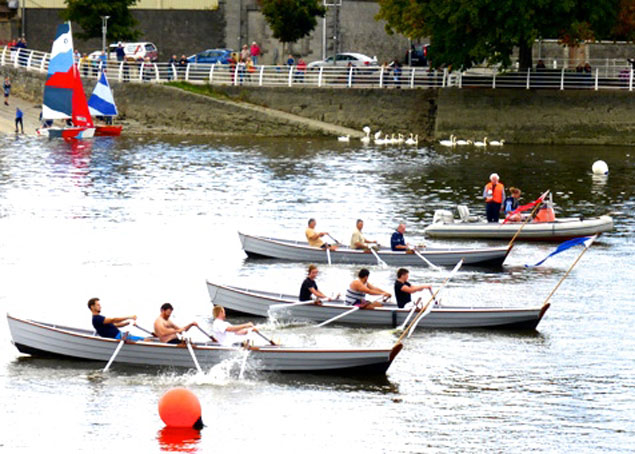 Although the gandelow was developed as a Shannon Estuary work and fishing boat capable of being slithered across mud, the Ilen Boatbuilding School’s scheme has resulted in the new fleet developing a racing programme. Photo: W M Nixon
Although the gandelow was developed as a Shannon Estuary work and fishing boat capable of being slithered across mud, the Ilen Boatbuilding School’s scheme has resulted in the new fleet developing a racing programme. Photo: W M Nixon
 This “mini-gandelow”, just 15ft long, will be at Glandore. She was built in Gloucestershire in England by Patrick Beautement, who had worked as a volunteer in the Ilen Boat Building School in Limerick
This “mini-gandelow”, just 15ft long, will be at Glandore. She was built in Gloucestershire in England by Patrick Beautement, who had worked as a volunteer in the Ilen Boat Building School in Limerick
But the influence of the Shannon Estuary doesn’t stop there, as another Glandore debutante will be the characterful 25ft cutter Sally O’Keeffe from Kilrush. She was built as a community project in Querrin on the south shore of the Loop Head Peninsula in a successful attempt to re-create the sailing hookers of the Shannon Estuary which served the many little local ports such as Querrin in times past. Naval architect Myles Stapleton gave the Querrin folk a wonderful design which draws its inspiration from the old vessels, but adds a little bit of its own magic stardust for a fine little ship which will be sailing from Kilrush to Glandore.
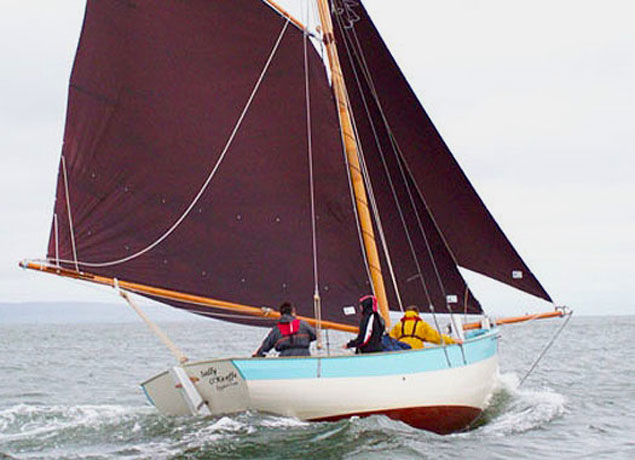 The attractive 25ft cutter Sally O’Keeffe of Querrin will be sailing the long oceanic haul from Kilrush to Glandore for the Classic Regatta
The attractive 25ft cutter Sally O’Keeffe of Querrin will be sailing the long oceanic haul from Kilrush to Glandore for the Classic Regatta
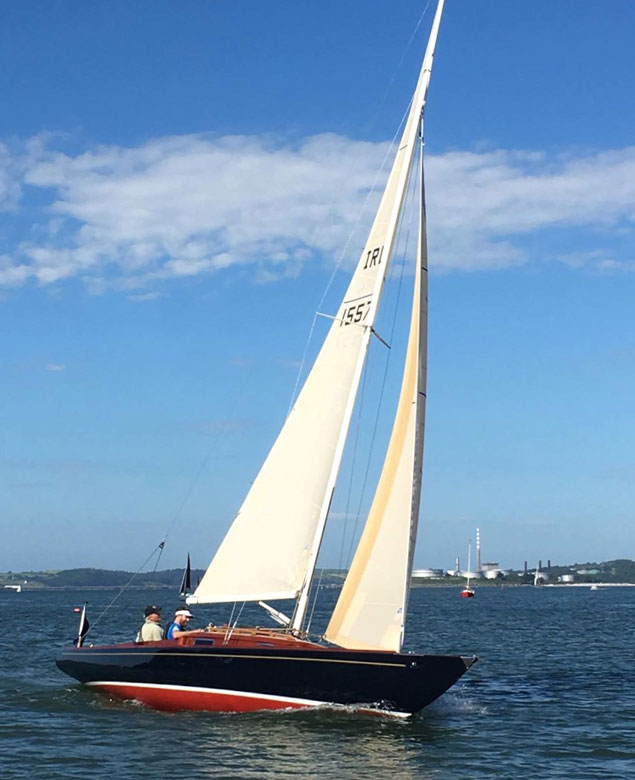 etchells guapa7 The classics experts at Glandore will be keen to give their opinions on Guapa, the extraordinary re-configuration of an Etchells 22 by Bill Trafford of Alchemy Marine.
etchells guapa7 The classics experts at Glandore will be keen to give their opinions on Guapa, the extraordinary re-configuration of an Etchells 22 by Bill Trafford of Alchemy Marine.
While it was a shed in Querrin that produced the Sally O’Keeffe, another distant shed away to the eastward at Skenakilla Crossroads in north Cork near Mitchelstown saw the irrepressible Bill Trafford working away on what started as a standard Etchells 22 of a certain age, but has emerged a year later as the unique and very elegant Guapa, an astonishing transformation which will certainly find people in Glandore who will appreciate the time and talents that have gone into her creation.
But in addition to modern twists on classic themes, Glandore Harbour will be well populated by what we might call classic classics, with the pace being set by the locally-based fleet of Classic International Dragons, which set so many records in terms of racing longevity and major international trophies won far back in the previous Millenium that it’s arguable that they should be a listed species.
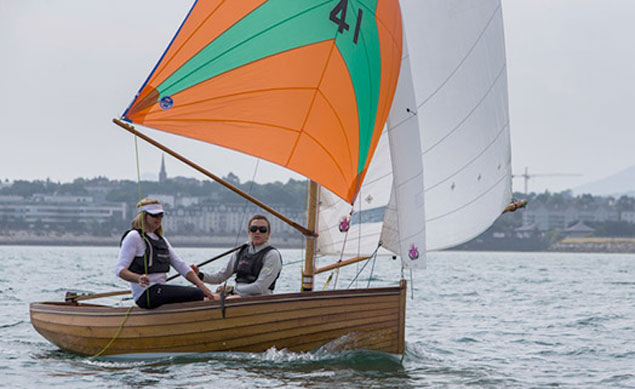 Cathy MacAleavey (left) sailing a family Water Wag with her daughter, Olympic Silver Medallist Annalise Murphy. The lines of the current Water Wag fleet were drawn in 1900 by a woman designer, Maimie Doyle, daughter of builder James E Doyle of Kingstown.
Cathy MacAleavey (left) sailing a family Water Wag with her daughter, Olympic Silver Medallist Annalise Murphy. The lines of the current Water Wag fleet were drawn in 1900 by a woman designer, Maimie Doyle, daughter of builder James E Doyle of Kingstown.
Another even more vintage racing class of 100% Irish origins that has already been strutting its stuff big time in 2017 at both the Semaine de Morbihan in Brittany at the end of May, and the recent Dun Laoghaire Regatta in Dublin Bay, is the Water Wags from Dun Laoghaire. They expect to muster nine boats at Glandore. And in addition to including many noted women sailors with the Murphy/MacAleavey family in particular making a big input, it should never be forgotten that when the original 13ft Water Wags of 1887 vintage decided to trade up to a larger 14ft-plus dinghy in 1900, the new design was by a woman.
The order for their construction may have gone to noted Kingstown boatbuilder James Doyle, yet it was his talented daughter Maimie who actually designed the boats. But then, the Water Wags were always ahead of their time, and the word is that in Glandore they’ll be demonstrating their special skill at Synchronised Sailing. This may tempt the Ette Class visiting Glandore from Castletownshend next door to try something similar, but we’re told it’s not as easy as it looks.
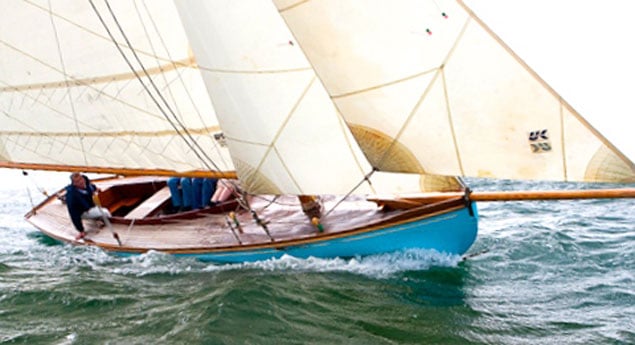 No Classic Regatta would be complete without a design by William Fife, and Patrick Dorgan’s Cork Harbour One Design Elsie, which will be at Glandore, is of a Fife-designed class that first raced in 1896.
No Classic Regatta would be complete without a design by William Fife, and Patrick Dorgan’s Cork Harbour One Design Elsie, which will be at Glandore, is of a Fife-designed class that first raced in 1896.
The great name of William Fife as a designer will also be present with the 1905 Clyde Thirty Brynoth, and the Cork Harbour One Design Elsie (Patrick Dorgan), of a time-honoured design which first appeared in 1895-96.
From time to time, these golden oldies benefit from the attention of sympathetic and highly-skilled boatbuilders who understand their special needs, and West Cork is well-filled with such talent, with Rui Ferreira near Ballydehob emerging at Glandore to show his skills with his restored 1936-vintage Flying Fish, which he somehow finds time to work on between skilled jobs for other people.
 This is Flying Fish as she was shortly after Rui Ferreira of Ballydehob started work on her.
This is Flying Fish as she was shortly after Rui Ferreira of Ballydehob started work on her.
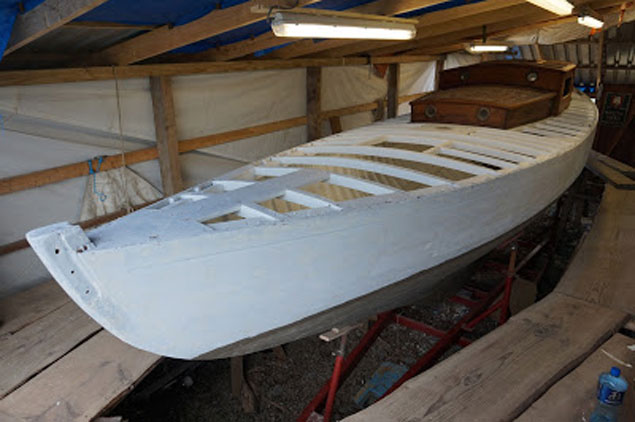 This is a more recent image of Flying Fish in Rui Ferreira’s workshop, but it is hoped that the finished restoration will be unveiled at Glandore in twelve days time.
This is a more recent image of Flying Fish in Rui Ferreira’s workshop, but it is hoped that the finished restoration will be unveiled at Glandore in twelve days time.
A sailing vessel which has punched way above her weight on Ireland’s behalf for many years now is the 76ft training schooner Spirit of Oysterhaven, and she’ll be at Glandore, an eloquent reminder of the fact that while we await government decisions on a new sail training ship, the Spirit of Oysterhaven has been gallant in filling the role in an unofficial capacity.
And in a year in which there seem to be more whales off the Irish coast than ever before, it’s more than appropriate that the fleet at Glandore will include the Irish Whale & Dolphin Group’s Research Vessel, the ketch Celtic Mist. In Glandore of all places, the sense of sea and land intertwining in a dynamic interaction is at its strongest, and Celtic Mist’s presence is reminder that our boats don’t just share the sea with other boats, we share it with an entire maritime world.
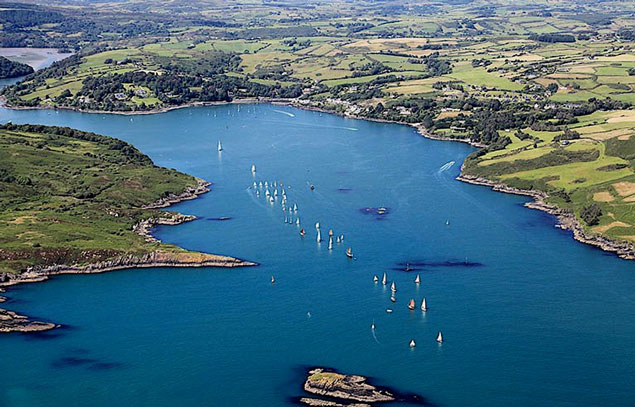 The Glandore Classic fleet on a calm day, gliding through the entrance to one of West Cork’s most beautiful inlet
The Glandore Classic fleet on a calm day, gliding through the entrance to one of West Cork’s most beautiful inlet
Riva Speedboats Gather For Historic Rally in Venice
#riva – About 50 vintage runabouts will meet in Venice, from 2 to 7 July, to take part to the great rally organised by the Riva Historical Society, the International Federation of historic Rivas that brings 700 owners from all over the world together. For five days, starting from the moorings at Darsena Sant'Elena, the fleet will visit the islands in the Lagoon, then parade on the Grand Canal for the great final parade of Sunday July 5.
MAY 2015 – From 2 to 7 July Riva Historical Society, the International association that brings together the owners of the most famous runabouts in the world, organizes the "Riva Days La Serenissima" in Venice. A fleet of about 50 wooden boats will arrive in the Lagoon to celebrate one of the greatest myths in the history of leisure boating.
The Riva runabouts taking part to the event, coming from Italy, Germany, Holland, France, Switzerland, Austria, Sweden, USA, UK, and the Principality of Monaco, were built between 1955 and 1983. All the models that made the history of the Yard will parade: Aquarama and Ariston, Florida and Tritone, Junior and Olympic and Saint Tropez. Some of these boats were once the property of famous people, like entrepreneur Attilio Monti, Perfetti of the candy industry, the sportman and entrepreneur Sergio Tacchini, countess Caracciolo and Carlo Riva himself.
The fleet will be based at the new marina Darsena Sant'Elena, a short distance from the historic Venetian Arsenal and the Navy school Francesco Morosini. From there the runabouts, divided into two groups called respectively 'Canaletto' and 'Palladio', will depart every day to cruise to the islands of the Northern Lagoon, like Mazzorbo and Burano, or the Southern Lagoon, to Pellestrina and Poveglia.
Visits are planned to the Serenella Shipyard and the glassworks in Murano, palaces and museums of Venice, the Venetian Expo "AQUAE". There will be stops for bathing and picnic, dancing and dinners, including one at the famous Locanda Cipriani in Torcello. Sunday July 5 the fleet will circumnavigate Venice to end in a great parade in the Grand Canal, with the crews attired in costumes pertaining the water world, real or fantasy, to compete for the Concours d'Elegance FREDERIQUE CONSTANT.
The event will end on Monday July 6 with a big gala dinner in the splendid halls of Cà Vendramin Calergi, the Venetian Casino. On this occasion the boats and the owners will be awarded, who distinguished themselves during the "Riva Days La Serenissima".
With this event the Riva Historical Society intends to repeat in the Venice area the same success as in 2012 during the Riva Days organized in Sarnico, on Lake Iseo. In that event, rightly called the largest gathering of a single brand in world boating, as many as 143 historic Rivas and 450 people from over 15 Nations celebrated the 90th anniversary of Carlo Riva. For the first time it was possible to see at least one of all Riva models ever built.
Riva Historical Society
Riva Historical Society, founded in Milan in 1998, is the international association that protects and promotes the culture of the most famous wooden runabouts in the world. The approximately 700 members divided into 13 departments, are from more than 30 nations in the 5 continents.
Historic President of the Riva Historical Society is the Milanese architect Piero Maria Gibellini, official biographer of Carlo Riva and member of the Powerboat Commission of ASI (Italian club of historic motor vehicles). Gibellini wrote 7 encyclopedic volumes now considered by experts the complete works on the history of the Riva yard. His latest work, Riva Historical Registry RHS, the product of 15 years of research, collects more than 800 images and a census of over 2300 Riva boats still sailing in 40 different Countries.
Every year, in the spring, the Riva Historical Society organizes a training course for "judges", in order to pass on to future generations the theoretical and practical knowledge related to the restoration and maintenance of a Riva speedboat. On that occasion, the trainees would visit a number of restoring yards, both in Italy and abroad, where they learn live how to become scrutineers.
Ainmara Ballad Video Tells The Story of Classic Yawl
#ainmara – A shanty sung by Jim Uprichard tells the tale of the Dickie Gomes skippered and self-maintained 102-year-old 36ft–yawl Ainmara that has featured regularly on Afloat.ie
The brief youtube video (above) of Dickie Gomes' Ainmara shows clips from a 'reunion' cruise to the Western Isles in July with Ed Wheeler in Witchcraft and Pete Adams, Jesz Fleming, Geordie Lynas, Dave Witherow and his Kiwi friend John 'Two Pies' Dean.
2015 Sailing Calendar Includes Two Bicentenaries & Ireland's Biggest Regatta At Dun Laoghaire
Irishsailing – After the remarkable across-the-board success of the 2014 Irish sailing season, 2015 will have to be very special indeed to be remembered with such enthusiasm. But it's a special year in any case, as two major sailing Bicentenaries – one in the Irish Sea, the other in the Solent – will have added and poignant meaning, as the Centenaries a hundred years ago could not be celebrated because of the First World War.
As for Irish sailing generally, life moves on, there are new sailors on the water, successful young sailors are graduating to the next stage of their rapidly developing careers, and established stars continue to plan fresh campaigns, for sailing is indeed a sport for life.
Then too, new fixtures successfully introduced in 2014 will require nurturing, tuning and encouragement if they are to fulfil their potential in the coming year, while at the same time there's always extra effort needed to give proper support to established fixtures, which have to live with the reality that they might wilt through being taken for granted. Both new and longer-established boat classes will need continued enthusiastic involvement, and our well-loved classics and traditional craft must be cherished and sailed, for lack of use is the real enemy of boats, whether old or new.
As for the major administrative initiatives introduced in 2014, they will need constant monitoring, but deserve full support from the sailing and boating community at large, for it was in response to a grass-roots initiative that the radical and very necessary reforms of the Irish Sailing Association were undertaken. Those appointed to undertake the root-and-branch reform of the national authority have done so with commendable dispatch, so it is now the duty of the rest of us to support their continuing efforts. And we can best do that by enjoying our boats and our sailing and time afloat in its myriad of interests, while encouraging others to do the same. W M Nixon outlines on what the coming year may bring.
One thing at least is certain for the coming season afloat during 2015 in most of Europe. It will not mark any significant sailing Centenaries. Instead, we are immersed in four years of remembering the Great War of 1914-1918 a hundred years on, with all the added twists of that period's longer historical narrative in Ireland. In such a context, it may seem frivolous to point out that sports like yachting have no great Centenaries to mark at all in 2015. But this minor off-screen fact is a reminder of the all-involving horror and obscenity of total warfare on an industrial scale. It obliterated anything like normal life.
Yet as recreational sailing had been going on in some sort of organised form for hundreds of years – albeit in a fairly rudimentary way in its earliest years in the 16th Century – there may well have been several important dates to be marked during the time of the Great War itself, but they were allowed to pass as there was no sport afloat, while civilian life ashore was very subdued.
And in Ireland, with the Troubles persisting for four years after the end of the Great War until 1922, the Bicentenary of the Royal Cork Yacht Club in 1920 was to be a muted affair – the official History of the Royal Cork Yacht Club (published 2005) tells us: "Plans for a special dinner to celebrate the club's bicentenary in 1920 had to be cancelled, probably because of the disturbed conditions in the country"
So the idea of celebrating the Centenary of the Royal Yacht Squadron in Cowes in 1915 at the height of the international war - other than in a rather solemn shorebound way - would have been unthinkable. But that in turn fuels the celebrations when the peacefulgood times roll again. Thus the Royal Cork Yacht Club, having been unable to celebrate its Bicentenary in 1920, went on to have a fabulous two-year Quarter Millennium celebration in 1969-70. And as the RYS couldn't have a proper party in 1915, there's no doubt that the up-coming Bicentenary in 2015 will be the nucleus of international sailing's megafest-of-the-year.
There are of course several clubs which pre-dated the Squadron when it was founded in 1815. And there are many whose members outshine the small membership of the RYS in the breadth and energy of their sailing. But for 2015, let's just acknowledge that the prestigious Squadron has been at the heart of sailing history for a very long time, while their clubhouse's location right on the Solent at Cowes is so central that when any great Solent-related events are under way, the Squadron is in the middle of the story.
Thus it was on the Squadron lawn that in July that the Irish team celebrated their epic Commodore's Cup victory at the end of July 2014. And it will be towards the Squadron and its Bicentenary that the fleet will be racing in 2015's west-east Transatlantic Race. And then it will be the firing of the cannons from the historic Squadron battery which will signal the start of the 46th Fastnet Race on 16th August 2015.
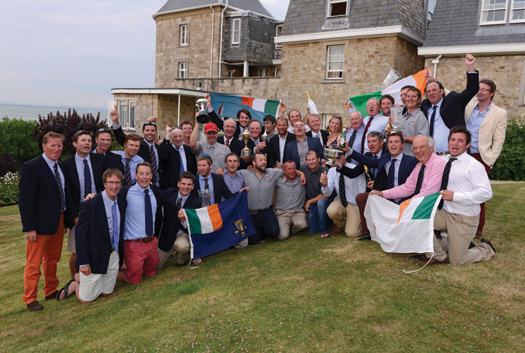
Party time at the Royal Yacht Squadron – the Irish team and their management gather to celebrate victory in the Commodore's Cup at the Squadron Castle in Cowes on August 1st 2014
There'll be many Irish boats involved, and the best-placed of them at the finish will be the winner of the Gull Salver, currently held by Martin Breen's Reflex 38 Lynx from Galway Bay SC, which was skippered to success by Aodhan FitzGerald in 2013's race. It's a coveted trophy, instituted to honour the memory of Harry Donegan of Cork and his famous cutter Gull, which was one of seven boats which inaugurated the Fastnet Race in 1925, and placed third. Since then, Irish Fastneteers have frequently been in the great race's top places, and best of all was in 2007 when Ger O'Rourke's Cookson 50 Chieftain out of Kilrush, sailing under the burgee of the revived Royal Western of Ireland YC, came sweeping in to the finish line at Plymouth to win the Fastnet Race
overall.
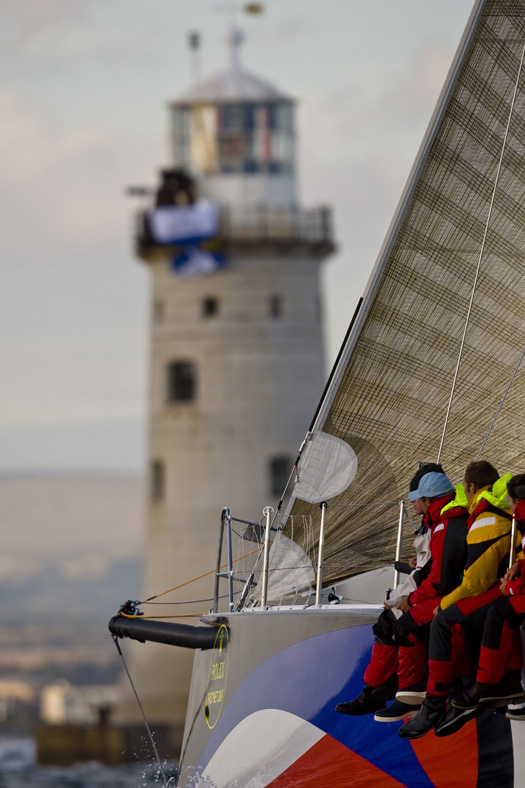
One of the greatest moments in Irish sailing history – Ger O'Rourke's Chieftain sweeps towards the finish line to become the overall winner of the Rolex Fastnet Race 2007. Photo: Rolex
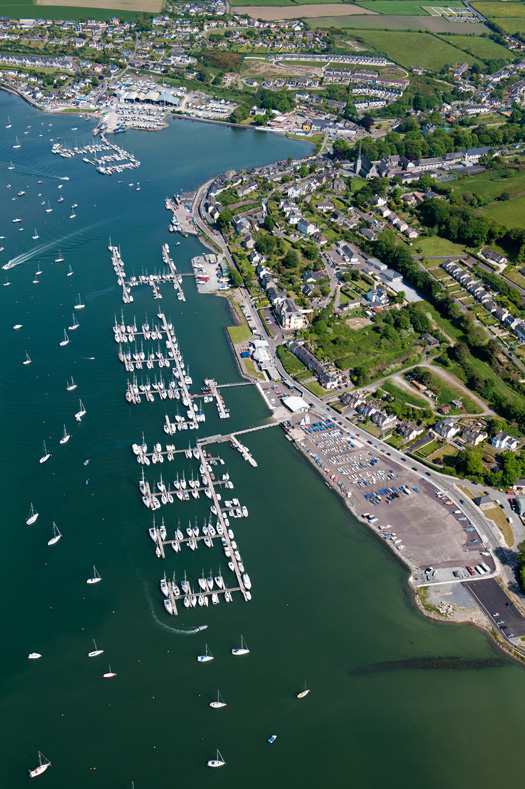
Just the spot for a great Tricentenary celebration - the very complete sailing facilities provided jointly by the Royal Cork Yacht Club and Crosshaven will become a world focus in 2020 with the Club's 300th anniversary. Photo: Bob Bateman
The realisation that 2015 sees this significant RYS Bicentenary is a timely reminder that the Royal Cork's Tricentenary is only five years down the line. They're five years which will be gone in a flash, and already behind-the-scenes moves are afoot to ensure that the national sailing programme will properly facilitate the extraordinary anniversary being celebrated in Crosshaven in 2020.
But meanwhile other Irish sailing centres have their own regular programmes to operate in the intervening four years, and in terms of numbers and scale there's no doubt the top event in Ireland in 2015 will be the biennial Volvo Dun Laoghaire Regatta from 9th to 12th July.
Anyone – and there were many - who took part in this unique "suburban sailfest" in 2013 will know that the VDLR has come of age. It's an event which is comfortable with itself while at the same time being always in development and evolution mode. Each staging of this remarkable Dublin Bay happening sees lessons being learnt and implemented even while the multi-class racing is under way on several courses. And in the two year gap before the next staging, the experience gained is closely analysed and the programme refined to further improve the sport in every area.
You get some idea of the sheer depth of racing experience in Dun Laoghaire by noting that the Chairman of the 2015 Committee is Tim Goodbody, with Martin Byrne as Vice Chairman while the Race Director is Con Murphy. And those three sailing megastars are just the peak of a mountain of race administration experience which is being drawn in from all over Ireland to ensure that the fleet of 400-plus boats gets the best sport possible.
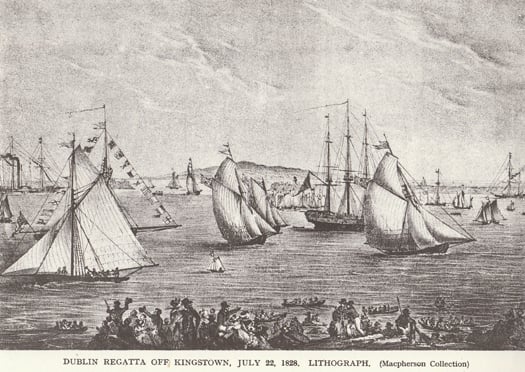
The first regatta in 1828 at the new harbour at Dun Laoghaire, which will be the setting for Ireland's biggest event in 2015, the Volvo Dun Laoghaire Regatta from 9th to 12th July.
While there'll be keenly participating boats from all over Ireland as well as Scotland, England and Wales, the setup of Dublin Bay being right on the city's doorstep means that it's the locals who would pose an administrative problem for a less experienced team. As the dates for the VDLR approached in 2013, the weather forecast steadily improved, and thanks to the Regatta's "extra long weekend" format, the sudden arrival of summer meant that a host of boats from the greater Dublin area came in as last minute entries, their owners and crews managing to scrape the extra day-and-a-half needed off work. It's a scenario which would put an overstretched administration off course, but the VDLR team took it calmly in their stride, and the result was a successful summer festival of sunlit sails and great sport, with maybe two thousand taking part.
This year there's a more structured cross-channel involvement, as the venerable Royal Dee YC in Cheshire has leapt to life to celebrate its Bicentenary. Founded as the Dee Yacht Club in 1815 with the end of the Napoleonic Wars, it didn't get the Royal seal until 1947, but nevertheless claims to be older than the RYS. With growing fleets in North Wales and the Mersey, it has put together a Bicentennial Royal Dee Irish Sea Offshore Championship linked closely to ISORA, which will bring the fleet across to Ireland to take in four offshore day races sailed as part of VDLR 2015.
Irish National Championships which will be part of the VDLR 2015 programme include the J/109s, the RS Elites, the Beneteau First 21s, and the Wayfarers, while the Leinster GP 14 Championship is also included as an integral part of the Regatta.
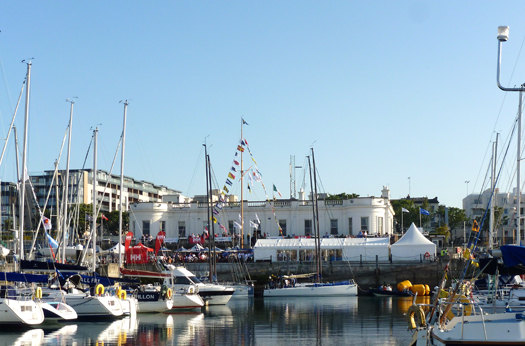
Party time in Dun Laoghaire – the Royal Irish YC during VDLR 2013. Photo: W M Nixon
As for Ireland's classic clinker-built vintage classes, one of the pleasantest surprises in VDLR 2013 was the large turnout of Mermaids, which had superb racing on the course area in the northwest corner of Dublin Bay. Despite having been born as the Dublin Bay SC Mermaid in 1932, this class of 17ft super-dinghies is no longer included in the regular DBSC programme owing to shortage of numbers for weekly turnouts. But it seems that as far as the VDLR is concerned, the Mermaid is now an event boat, and the fleets still thriving at other centres, together with some of the dormant Dublin Bay craft, bestirred themselves for the four days to enjoy good sailing for more than three dozen boats, something which is highly likely to be repeated in 2015.
The even more venerable Water Wags, founded 1887 with the current boats dating from 1903, continue to thrive in Dun Laoghaire, and the word is they expect to have at least twenty boats in action, while another wooden classic, the Mylne-designed 25ft Glen keelboat, is 50 years and more in Dun Laoghaire, and looks forward to having at least twelve boats racing in 2015.
All these specialized and historic classes are in addition to the numerous cruiser-racers which continue to be the backbone of Dublin Bay sailing. And while many of them will see the VDLR 2015 as a highlight of the year, in turning to consider the overall national programme, we find a sport which is shaking off economic recession to get on with an extraordinary plethora of local, national and international sailing events.
The problem is that most events of significance hope to locate themselves in the peak sailing period from late May to early September, so clashes are almost inevitable, and if you're interested in several different kinds of sailing, the overall choices can be bewildering in their complexity and logistical challenges.
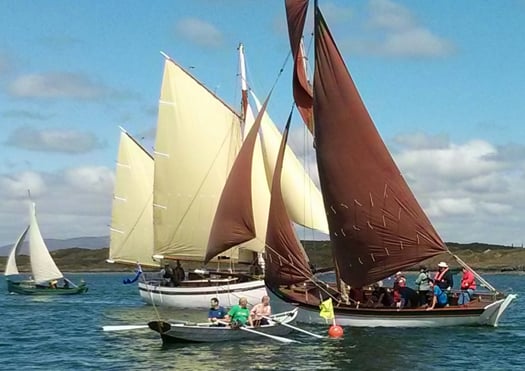
The Baltimore Wooden Boat Festival attracts an eclectic fleet – included here are a Shannon Gandelow, a West Cork Mackerel Yawl, the ketch Sile a Do, and an Heir Island Lobster Yawl (left).
For instance, the variety of events now available for the traditional and classic boats – usually but not necessarily under the Old Gaffer umbrella – would keep anyone busy for most of the summer. It starts with the Baltimore Wooden Boat & Seafood Festival from Friday 22nd May to Sunday 24th May, which you'd think very early
in the season for someone faced with fitting out an old wooden boat in Ireland's climate, but somehow they do it.
Then on the East Coast for the early summer Bank Holiday Weekend from May 29th to June 2nd, there's the Old Gaffer gathering in Dublin Bay at Poolbeg Y&BC with the annual race for the Leinster Trophy in the bay on Saturday May 30th, the event then morphs into the Dublin Port Riverfest in the Liffey on Sunday May 31st, and finally it all concludes with the race for the Asgard Trophy back in the bay on Monday June 1st.
The annual Lambay Race at Howth, a regular fixture since 1904, has seen its course becoming increasingly complex in modern times in order to satisfy the desire of modern racers for competition on every possible point of sailing. But in 2014, to celebrate the Centenary of the Lynch family's Echo, the venerable Howth Seventeens were sent on the traditional course north from Howth Harbour through the sound inside Ireland's Eye, then on round Lambay leaving it to port, and then back south inside Ireland's Eye again to the finish at Howth pierheads.
This was such an attractive proposition for Old Gaffers and Seventeens alike that on the day an extra Classics Division was added to cater for ancient craft, and it hit the spot. This option will be offered again for 2015's Lambay Race (it's on Saturday June 6th), and the word is that Dickie Gomes's 1912-built 36ft yawl Ainmara will be coming down from Strangford Lough to defend her title after 94 years. 94 years? Yes indeed - she won the Lambay Race in spectacular style in 1921 when still under the ownership of her designer-builder John B Kearney.
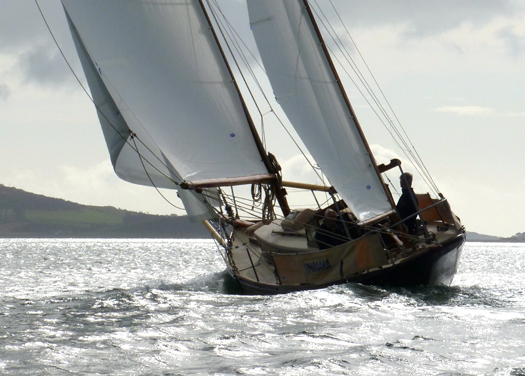
After 94 years, Dickie Gomes's 36ft 1912-built yawl Ainmara (seen here on her home waters of Strangford Lough) hopes to return to defend the title in Howth's Lambay Race, which Ainmara won in 1921 while still in the ownership of her designer-builder John B Kearney. Photo: W M Nixon
The Old Gaffers attention then swings north as the Tall Ships are coming to Belfast from Thursday 2nd July to Sunday 5th July. This is going to be a serious biggie with those ships already signed up including a significant turnout of Class A vessels, which are square riggers and others of more than 40 metres in length. Belfast Lough lends itself particularly well to the Parade of Sail which follows a Tall Ships gathering, and in 2009 when they were last in the port they put in in a virtuoso display with the Dutch ship Europa in particular going to the trouble of getting herself over towards Whiteabbey in the northwest corner of the lough to allow her time get every stitch of sail set before proceeding seawards down-lough in colossal style, a much more impressive display than we've become accustomed to in Dublin, where the shape of Dublin Bay is such that it doesn't really provide the space for square riggers to set all cloth before getting out to sea.
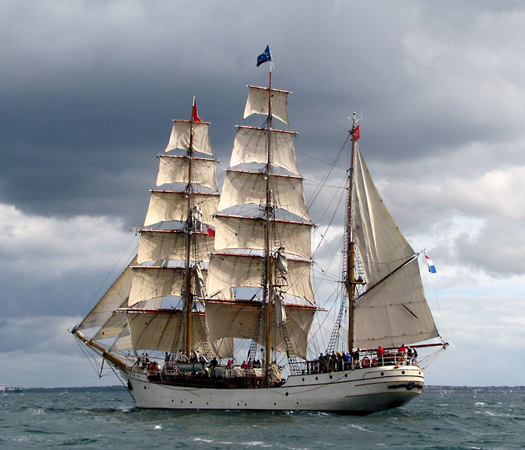
The Tall Ship Europa shows how it should be done in Belfast Lough in 2009, taking time out to set full sail before she starts to gather power to make the proper input into the Parade of Sail.
Like Dublin, Belfast has shown it can be hospitable to Old Gaffers, and it was a very welcoming main port during the OGA Golden Jubilee Cruise-in-Company in 2013, so for 2015 the OGA National President Sean Walsh hopes to up the ante by persuading his members from all round the Irish Sea to gather in Belfast, and to add spice to the mix, he hopes to persuade the Howth 17s to put in an appearance as well, to sail with local one designs like the 1903 Belfast Lough Waverley Class, which have been experiencing a revival in recent years.

Old Gaffers in Belfast for their Golden Jubilee in 2013. The Irish Sea classic and traditional fleet will return to the same venue for the Tall Ships gathering in July 2015. Photo: W M Nixon
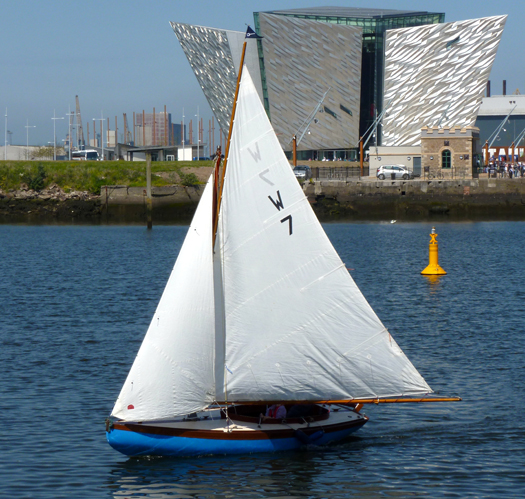
The Belfast Lough Waverley Class Lilias (built 1903) sailing at the Titanic Centre in Belfast. In 2015, the Waverleys will be joined by some of the 117-year-old Howth 17s to participate in the visit of the Tall Ships. Photo: W M Nixon
The Seventeens have made long treks as a class before – in 1998, five of them were road-trailed to Carrickfergus to mark the class's Centenary, with the first five boats built by Hilditch of Carrickfergus. So though they'd trailed there, they then sailed the 90 miles back to Howth, just as the first boats had done a hundred years earlier. Then in July 2003, fifteen of the Seventeens took part in the Glandore Classics Regatta thanks to a brilliantly organised exercise in logistics using a flotilla of low loaders which could take three boats apiece.
For all of Ireland's classic and traditional boats in 2015, and an international fleet too, Glandore is very much up on the radar again, as a special effort is being made by a GHYC team led by Donal Lynch to encourage increased numbers in the CH Marine Glandore Classic Regatta from Saturday July 18th through Friday July 24th. It's a date which certainly allows Old Gaffers plenty of time to get down from Belfast, indeed some may even consider the option of making the voyage northabout to take in a round Ireland cruise while they're at it. And as that great magnet of the Irish Sea classic and traditional scene, the Peel Traditional Boat Weekend, isn't until Friday 31st July to Sunday 2nd August, it's just about possible to factor that in as well.
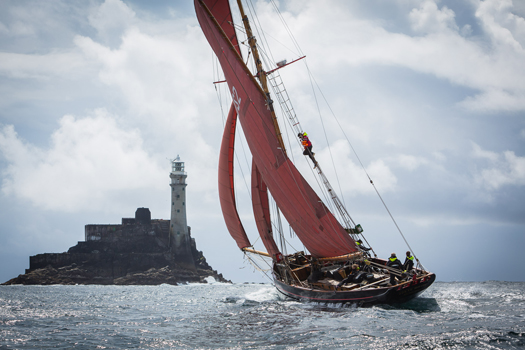
Everything happening at once – the famous Pilot Cutter Jolie Brise was the star of the Glandore Classics in 2013, and as it was her own Centenary she celebrated by sailing round the Fastnet Rock – she has been a successful Fastnet Race participant several times. Photo: Brian Carlin
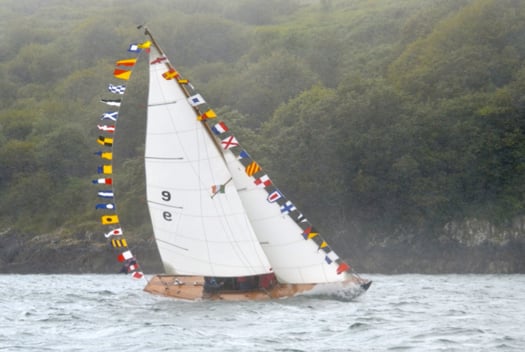
The Glandore Classics attracts an international fleet, and 2013's regatta included a class of Fife One Designs from the Menai Straits, all of them keen to party and showing it. 2015's Glandore Classics is from July 18th to 24th. Photo: Cormac O'Carroll
All this is already happening for the oldies with August barely under way, yet for modern cruiser-racers the potential programme for any keenly-sailed Irish boat is equally complex, attractive and challenging. The season starts as usual with the Scottish Series from Friday 23rd May to Monday 26th May – there'll probably still be snow on the mountains of Arran. They've gone back to their roots by starting with a feeder race from Gourock to the main regatta centre at Tarbert on Loch Fyne. "Going back to the roots" is something of a theme for this year's staging of the Clyde Cruising Club's main racing event, as this is the 40th Scottish Series. Come to think of it, there are so many important 40th anniversaries happening in sailing these days that we have the admit that the decade which brought us the full horror of wide lapels and flared trousers also contributed some lasting elements of the international sailing scene, indeed it could be said that the modern era in sailing really began about forty years ago.
Back in Ireland, the ISORA programme will be well under way by June, while the Lambay Race on June 6th can be looked at with more interest by several boats, as the biennial National YC Dun Laoghaire to Dingle Race doesn't start until Friday June 12th . Last time round, there was a total fixtures clash between the two events, but in times before that hyper-keen sailors such as the Tyrrells of Arklow with Aquelina have been able to fit in both, indeed one year they did it so well they won both too, and were rightly acclaimed as the Afloat "Sailors of the Month" for their success.
For 2015, defending champion in the Dingle Race is Brian O'Sullivan of Tralee with the veteran Oyster 37 Amazing Grace, which came good in the end in 2013 with a new breeze which knocked pending leader Antix (Anthony O'Leary) off the winning perch. But with the 2015 Dingle Race acting as a useful if rather indirect feeder for the Covestone Asset Management Sovereigns Cup in Kinsale from June 24th to 28th, there could be all sorts of sharp boats lining up to take the prize, for the Sovereigns Cup 2015 includes the all-singing all-dancing ICRA Nats 2015.

The welcoming port – Kinsale is one of Ireland's most popular destinations, and in 2015 its hosts the combined Sovereigns /ICRA Nationals from June 24th to 28th.

Perfect sailing – racing in the Sovereigns at Kinsale in June 2013. Photo: Bob Bateman
Yet the timing of the combined Sovereigns/ICRA Nats is such that there's still plenty of time and space to get back to the Irish Sea for the Volvo Dun Laoghaire Regatta 2015 from July 9th to 12th, a reminder that much of the cruiser-racer programme for 2015 is in a neatly balanced and user-friendly timescale for everyone except perhaps those who wish to do either the entire ISORA or SCORA programme as well, so the problem mostly is going to be getting time off work.
And for the hyper-keen cruiser-racers, particularly those whose boats are small enough to be conveniently trailerable, further temptation looms in 2015 with the WIORA Championship at Galway Bay Sailing Club from July 22nd to 25th. For the fleets in the Shannon, on Tralee Bay, and in Clew Bay, it's a bit more than a day's sail away, but they'll be there to challenge Liam Byrne of the home club who won it in 2014 with his Corby 25 Tribal at Mayo SC in Clew Bay, while some top boats from more distant centres are expecting to trail to Galway Bay to spice up the competition.
By this stage of the season a more relaxed pace might be welcome, but the lively turnout of 80 boats in 2014 for the new-style four day Cork Dry Gin Calves Week out of Schull in early August (Tuesday 4th to Friday 7th August in 2015) suggests that for racing sailors, the best relaxation is more racing, but in a holiday setting. And yes, it has been noted that a true West Corkian sailing nut could indeed do all of Calves Week 2015, and still be on the Squadron line for the start of the Fasnet Race nine days later.
For dinghies in 2015, the big story is the debut of the newest version of the National 18, and just how popular will the Bray-bult foiling Moths become, while established classes will frame their programmes to accommodate sailors whose time is limited, also having to fit in with a national scene where the number of Race Officers with the necessary skills is inevitably a finite amount.
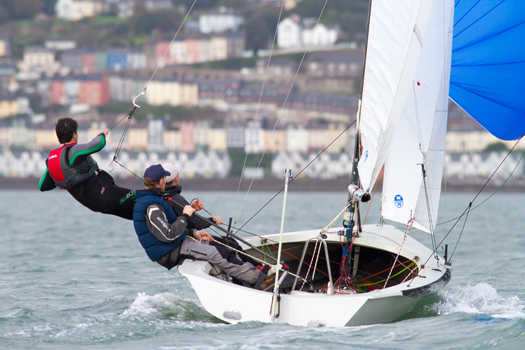
The big stories in Irish dinghy racing in 2015 will be the arrival of the new National 18s at Crosshaven, and the revival of Dinghy Week there in late August. Here, in the Autumn of 2013, To Dwyer and Nin O'Leary test sail the prototype of the new 18 on Cork Harbour. Photo: Bob Bateman
The new Third Generation (or maybe it's fourth or fifth generation) National 18 may have been designed in England by Phil Morrison, and is being built there too. But it was the very active Crosshaven fleet with the Royal Cork Yacht Club which led the charge towards a new boat, and when it came to stepping up to the plate to pay twelve substantial new boat deposits to move it all along after the prototype had been rigorously tested in Cork harbour last Autumn, it was the Crosshaven fleet that provided eight out of those twelve cheques.
So it's entirely appropriate that in August 2015, the dinghy focus will swing big time towards Crosshaven and a short form "Dinghy Week" from August 21st to 23rd. The old style Irish Dinghy Weeks – the last one was in 1970 – became victims of their own success, they just got too large. But the different classes became over-optimistic about their continuing individual growth prospects. Then the pendulum swung too far the other way, and dinghy classes were alone and their events shrinking. But a resurgence of club and championship dinghy sailing in Crosshaven during 2014, and a growing realization that over-reliance on single-handed dinghy classes does not necessarily produce a socially-adjusted national squad of junior sailors, resulted in some clear and creative thinking about developing two-handed boats, and reviving some old classes such as the Mirrors.
The form of this new Dinghy Week is still in the melting pot, but at least eight classes have responded with enthusiasm. Meanwhile, the National 18s in Crosshaven will be such a focus of interest during 2015 with the first of the new boats making their debut that we'll have a season-long dinghy narrative developing on Cork Harbour, and the revived Dinghy Week will be just part of it.
As for inshore keelboats, the big one in terms of number is the combined British and Irish Championship Squib Championship at Howth from 27th June to 3rd July. The handy little Squibs are something of an oddity, as they serve so well as a cherished local class in so many Irish sailing centres that many owners see them as that, and nothing more – handy little club sailors to be raced on home waters a couple of times a week.
This means that when a major regional or national event is held, the number taking part will often only be a fraction of the total Irish Squib fleet. But for those who do make the trek, the competition is fierce and the racing great – in Howth, the high point was in 1996, when this "Nationals" event attracted a fleet of exactly a hundred boats, and on one never-to-be-forgotten morning, there they were, every last one of them on the starting line.

A hundred Squibs all in a row at Howth on Tuesday July 25th 1996. Photo: Mandy Murnane
The most recent Squib event of national stature was the Freshwater Keelboat Regatta at Dromineer on Lough Derg on the weekend of October 18th-19th, and the battle for the top places was between the Kinsale and Belfast Lough fleets, with James Matthews and Rob Jacob of Kinsale rounding out their year in style with a good win.
But with the Squibs in England undergoing a revival – they were the second-biggest One Design fleet in Cowes Week 2014, bested only by the legendary XODs – there's no doubt there's a strong challenge coming across channel, and any Irish boat getting into the top ten will be doing well.
As for that annual Autumn Freshwater Keelboat Regatta at Dromineer, while it may have been much hampered by the spinoff from some ferocious weather out in the Atlantic with frustration for some of the sixty boats hoping to take part, it's an event of enormous potential, and the many who wish it well and have enjoyed it in the past will be ready and willing to do their part to make 2015's regatta a success.

The Squibs enjoying a lull in the strong winds during the Lough Derg Freshwater Regatta 2014. Overall winner was Mucky Duck (no 51, James Matthews & Rob Jacob, Kinsale YC). Photo: Gareth Craig
All these specialised and localized events planned for 2015 will be the continuing background music to the usual events of national sailing focus, everything from the selection of the Irish team for the Student Yachting Worlds to the Helmsmans Championships to the steady increase in pace while 2015 develops as the pre-Olympic year. As the year rolls along, other stories will develop too. So perhaps it's appropriate that we exit this review as we entered it. Just pause to remember now and again that, a hundred years ago, you simply couldn't have gone freely afloat like this for sport and recreation at all.
But we can't close on such a solemn note. Seasoned Solent sailors may have noted our header photo from Guido Cantini at the Panerai Classics Regatta was looking just slightly odd, for some reason difficult to pin down. Well, as it happens, the photo was sent to us back in September just as we were contemplating the excellent cleanup up done by Jason Hurley of Jason Hurley Design on the Mercedes-sponsored billboard photo of Howth 17s on the end wall of Howth Yacht Club. As with many photos taken over the RYS starting cannons, the Cantini pic included an obtrusive part of the Fawley Oil Refinery across on what Isle of Wight people call "the north island". Though Fawley has been there for yonks, it still has the look of a temporary structure. So we got Jason to treat as just that. But here for your edification is the true picture. You could get a taste for this sort of thing. What about brushing out Whitegate, lads? And as for Milford Haven.........
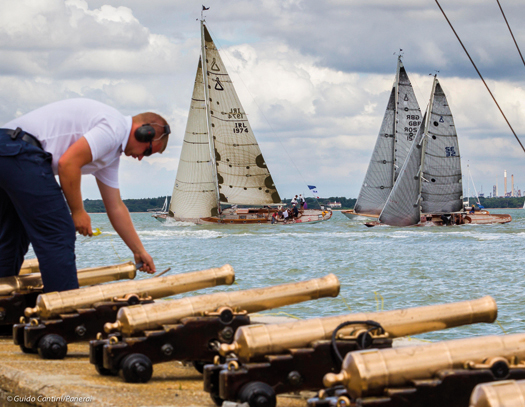
The unvarnished truth. In real life, the view from the RYS battery at Cowes can be slightly marred by the clutter of Fawley Refinery across the Solent on "the north island". Photo: Guido Cantini/Panerai
Read also: 2015 Irish Sailing Fixtures List (provisional)
Glandore Classic Regatta Programme & Notice of Race 2013
CH Marine GLANDORE CLASSIC REGATTA.
20th to 26th JULY 2013
Organising Authority
Glandore Harbour Yacht Club
NOTICE OF RACE
1 RULES & HANDICAP SYSTEMS
1.1 The regatta will be governed by the rules as defined in The Racing Rules of Sailing(RRS)
1.2 Handicapping will be under the KLR Formula (Klassiker Rennwert) for Classic Boats; ECHO for modern cruising boats and Portsmouth Yardstick for all dinghies and day sailing boats. Handicaps may be adjusted on a daily basis by the Race Committee as they deem necessary in the interests of all competitors.
1.3 The Irish Sailing Association Safety Regulations for day racing shall apply.
2 ADVERTISING
2.1 The Regatta will be a Category C event.
2.2 Boats may be required to display advertising chosen and supplied by the organizing authority.
3 ELIGIBILITY AND ENTRY
3.1 The regatta is open to all 'classic' sailing yachts and dinghies, and modern cruising yachts.
3.2 Eligible boats may enter by completing the Entry Form available online at: www.glandoreclassicregatta.com together with the required fee which can be paid by PayPal or on registration in the Regatta Office.
3.3 Yachts that are in possession of a Rating Certificate of any type shall submit these Certificates upon registration.
3.4 All competitors shall comply with the ISA or their own National Governing Authority eligibility requirements.
4 FEES
4.1 Required fees are as follows:
4.2 Race Entry Fees
40ft. LOA and above €100
30ft. to 39ft. LOA €85
20ft to 29ft €75
Up to 19ft & Workboats €45
4.3 Non Racing Entry Fees
Parade of Sail only €20
Crane In & 0ut €120
5 SCHEDULE
5.1 Registration: Saturday, July 20th, 2013, from 10.00hrs to 20.00hrs
All skippers must sign the Registration Form in the Regatta Office
5.2 Skipper's Briefing: Sunday, July 20th, 2013 at 10.30hrs
5.3 Racing for all classes:
Saturday, July 20th, 2013 none – crane in
Sunday, July 21st, 2013 none - Parade of Sail (PM)
Monday, July 22nd, 2013 Harbour & Offshore Racing
Tuesday, July 23rd, 2013 Fastnet Race
Wednesday, July 24th, 2013 Cruise/Race to Castletownshend
Thursday July 25th, 2013 Harbour & Offshore Racing
Friday July 26th, 2013 Harbour & Offshore Racing
5.4 There will be not more than 2 races per day for all harbour classes, except Friday when there will be 1 race.
On Sunday July 21st, there will be the Parade of Sail.
On Wednesday July 24th, the cruise/race to Castletownshend will take place.
5.5 The Warning Signal for the first race each day will be 12.30hrs.
Warning Signal times for the Fastnet, other offshore races and cruise/race to Castletownshend will be posted not later that 1800hrs on the day before the event.
6 SAILING INSTRUCTIONS
6.1 The Sailing Instructions will be available to boats on completion of registration requirements on Saturday, July 20th, 2013.
7 VENUE
7.1 The Regatta will be sailed in the waters of Glandore Harbour and Glandore Bay, approximately between Galley Head and Toe Head and to Fastnet Rock, Co Cork, Ireland.
8 THE COURSES
8.1 The courses to be sailed by classic yachts & modern cruising boats may include marks inside and outside Glandore Harbour.
8.2 The Sailing Instructions will include the details of courses to be sailed by all classes.
9 PARADE OF SAIL
9.1 The Parade of Sail will be at approximately 1500hrs hours on Sunday July 21st and will be sailed around marks within the harbour.
9.2 Directions for the Parade of Sail will be attached to the Sailing Instructions.
9.3 The Parade of Sail is treated as a 'race' for scoring purposes. All boats participating will be scored point's equivalent to 1st place. These points cannot be used in tie breaks and boats failing to participate shall be scored 'Did Not Start'. The parade of sail cannot be used as a discard in scoring.
10 PENALTY SYSTEM
10.1 The Scoring Penalty, rule 44.3, will apply to all classes except dinghies. The penalty will be 20%, rounded up to next whole number, of the total entries for the boats class added to the boats finishing score.
10.2 All boats, except dinghies, shall carry a yellow flag to signal acceptance of a scoring penalty.
10.3 For the dinghy classes, rule 44.1 is changed so that the Two-Turns Penalty is replaced by One-Turn Penalty.
11 SCORING
11.1 (a)When fewer than 5 races have been completed, a boat's series score will be the total of her race scores.
(b) When 5 races have been completed, a boat's series score will be the total of her race scores excluding her worst score.
(c) When 8 or more races have been completed, a boat's series score will be the total of her race scores excluding her two worst scores.
12 BERTHING
12.1 Visitor moorings are available in Glandore Harbour, a number of club moorings will be assigned to visiting fleets, and cruising vessels should be prepared to lie to their own ground tackle.
12.2 A water taxi will available for the duration of the regatta before and after racing and to schedule at other times.
13 HAUL-OUT RESTRICTION
13.1 Keelboats shall not be hauled out during the regatta except with and according to the terms of prior written permission of the race committee.
13.2 Lift in and Lift out will take place at Union Hall Pier. Lift in Lift out time will be posted closer to the regatta date.
13.3 Cost of lift-in and lift-out is not included in entry fee.
14 PRIZES
14.1 Prizes will be awarded in all classes.
14.2 The Regatta Committee may operate a system which restricts the number of prizes awarded to any one competitor.
15 DISCLAIMER OF LIABILITY
15.1 Glandore Harbour Yacht Club, members thereof, and any event Sponsor, are providing this series of races only on the understanding that the Club, its members, or the Sponsors, or its representatives, bear no responsibility whatsoever for any loss, damage or injury to any boat or person howsoever arising, directly or indirectly by any accident or wrongful or negligent act, default or omission of any person during the event.
15.2 It is the sole and exclusive responsibility of each owner or owners' representative to decide whether or not to start or continue to race.
15.3 Owners/Skippers shall acknowledge their responsibility on the Entry Form & Registration Form and draw the attention of their crew and associates to this disclaimer. Owners, skippers, helms and crew shall ensure that they are adequately insured against any claim against them, arising out of their participation in this event.
16 FURTHER INFORMATION
16.1 For further information and contacts check the Glandore Classic Regatta website at: www.glandoreclassicregatta.com or www.glandoreyc.com
Or use the links below
Diarmuid O'Donovan—Commodore Glandore Harbour Yacht Club
John Dowling—Vice Commodore Glandore Yacht Club & Classic Regatta Chairman
Bill Sandberg—Principal Race Officer
|
2013 CH Marine Glandore Classic Regatta Programme |
|
|
Day/Date |
Event |
|
July 15th t0 July 20th |
Arrival of Boats |
|
Friday 19th July |
Launch of Bantry Long-boats and Race |
|
Saturday 20th July LW 09:42 (1.0) HW 15:48 (3.6) |
Crane in |
|
Bantry Long Boats Race . Sack Transfer. Captain's Gig |
|
|
Official Opening in the square |
|
|
Sponsors Reception in the new Club House |
|
|
Jimmy Crowley & Stokers Lodge in Concert in Glandore Church |
|
|
Sunday 21st July LW 10:43 (0.8) HW 16:45 (3.8) |
Bantry Long-Boats Rowing Race |
|
Parade of Sail |
|
|
Music in the street with Two Time Polka (Sponsored by GLandore Inn) |
|
|
Fireworks |
|
|
Monday 22nd July LW 11:38 (0.6) HW 17:38 (4.0) |
Harbour Racing |
|
Offshore Racing |
|
|
Sail & Oar/Day boat Island Picnic |
|
|
RNLI Quiz in Casey's Bar |
|
|
Tuesday 23rd July LW 12:28 (0.5) HW 18:27 (4.1) |
Jolie Brise Cruise/Race to Fastnet Rock (20NM) |
|
Harbour Racing |
|
|
Sail & Oar Event |
|
|
Classic Ladies Lunch in The Rectory |
|
|
Wednesday 24th July LW 13:16 (0.5) HW 19:14 (4.1) |
Harbour Racing |
|
Offshore Racing |
|
|
Cruise to Castletownsend |
|
|
Gerald Butler, auther of "The Lightkeeper: A memoir" reading from his book in Hayes'Bar |
|
|
Thursday 25th July LW 14:02 (0.5) HW 19:59 (4.0) |
Harbour Racing |
|
Offshore Racing |
|
|
Sail & Oar event |
|
|
Regatta Dinner in The Rectory |
|
|
Friday 26th July LW 14:46 (0.6) HW 20:45 (3.9) |
Racing |
|
Sail & Oar event |
|
|
BBQ |
|
|
Grand Prize Giving |
|
|
Farewell Party |
|
|
Welsh Male Voice Choir in Glandore Church |
|
|
Saturday 27th July LW 15:31 (0.8) HW 21:31 (3.6) |
Crane Out |
|
V6
|
|



























